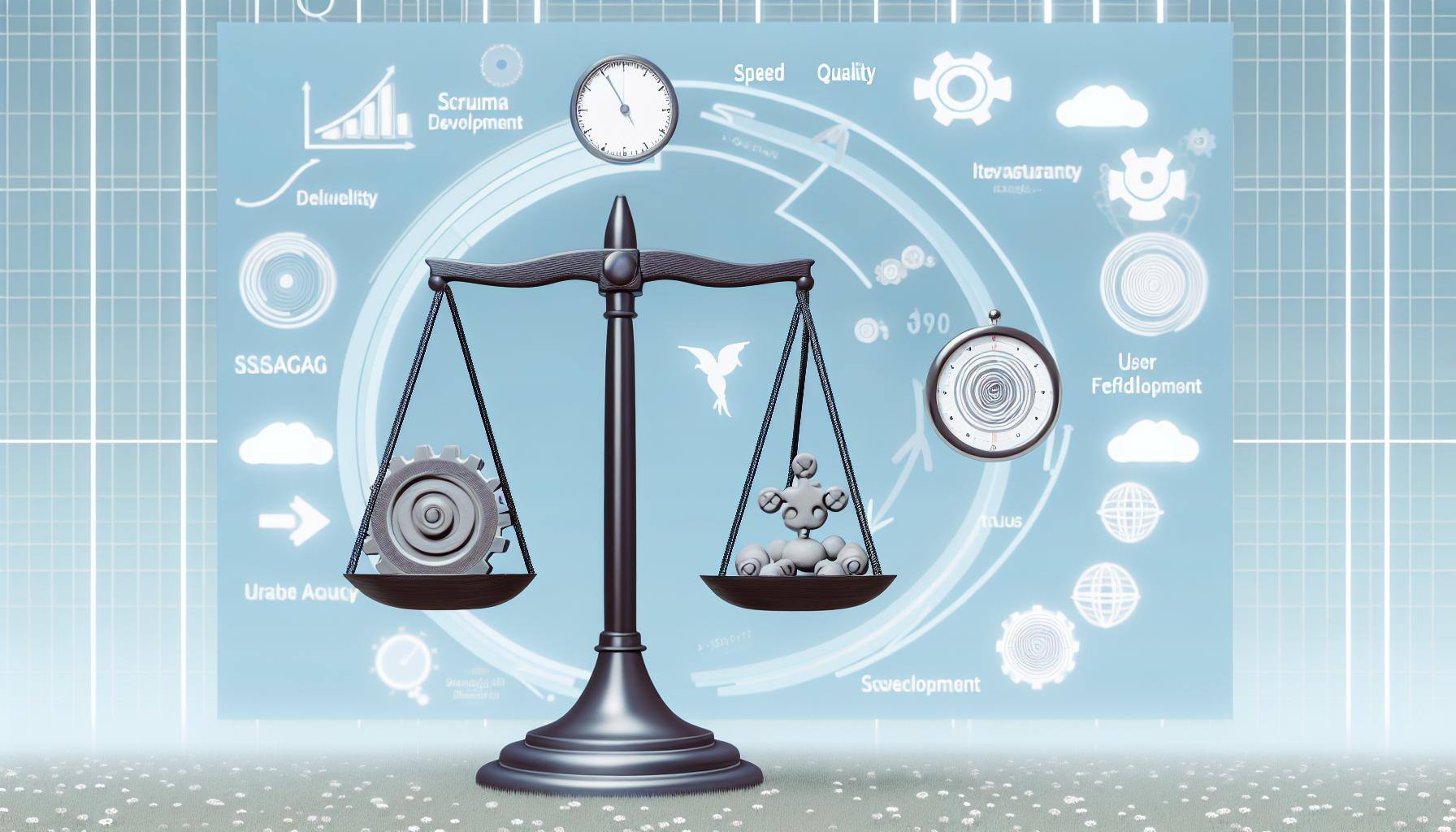Best Practices and Strategies for Building a Remote Team in SaaS
In the rapidly evolving landscape of SaaS (Software as a Service), the concept of a remote team has become increasingly prevalent. This shift towards...
6 min read
Brian Polackoff
:
Jun 14, 2024 9:39:00 AM

In today's rapidly evolving Software as a Service (SaaS) landscape, the pressure on SaaS companies to deliver new product updates swiftly, while still being able to maintain quality, is immense. Achieving a balance between speed and quality in SaaS product development is not just desirable—it's essential for staying competitive and meeting market demands. This article explores strategies and methodologies that enable SaaS development teams to optimize their workflow, improve product quality, and accelerate time to market without sacrificing one for the other.
Agile methodologies are at the heart of successful SaaS product development, enabling teams to balance speed and quality effectively. Agile's flexible, iterative approach to software product development allows for continuous feedback and adjustments early in the development cycle. This adaptability helps in addressing pain points and incorporating new features promptly, ensuring that the product evolves in alignment with user needs and market demand, a crucial strategy in the competitive world of SaaS. By breaking down the development process into manageable iterations, agile enables product teams to streamline workflows, prioritize crucial tasks, and maintain a high standard of quality assurance throughout the lifecycle of the product development.
Iterative development, a core component of Agile methodologies, plays a pivotal role in streamlining the SaaS development process to prioritize speed while achieving the right balance with quality. This approach encourages the building of a Minimum Viable Product (MVP) and subsequent iterations based on user feedback and insights, reflecting an effective product management strategy. Iterative development not only hastens the delivery of new features but also continuously refines the user experience (UX) by addressing real user needs and feedback with each iteration. This method ensures that the development team can promptly react to changes in market trends and user preferences, enhancing customer satisfaction while maintaining a swift development pace.
Agile development is instrumental in aligning product development efforts with overarching business goals and the product vision. Through its iterative nature and emphasis on stakeholder engagement, Agile methodologies ensure that every aspect of the SaaS product development—from the initial product design to the final deployment—is in harmony with the SaaS business's objectives and the target market's needs. This alignment is critical for building a product roadmap that not only addresses current market demands but also anticipates future trends, keeping the SaaS solution relevant and competitive.
Identifying and prioritizing features for an MVP is a crucial aspect of agile product strategy. SaaS product managers must adopt a customer-centric approach to discern the essential features that meet core user needs and deliver value early in the development lifecycle. By focusing on key functionalities that align with the product vision and solve specific pain points, SaaS companies can optimize development resources, streamline the product roadmap, and accelerate the time to market. Engaging with stakeholders and prospective users during this phase can provide invaluable insights to refine the feature set and prioritize development efforts effectively.
Feature development has a profound impact on the SaaS user experience. Every new feature introduced must enhance functionality, usability, or overall satisfaction without complicating the user interface (UI) or the user’s journey. SaaS development teams must continuously evaluate the user experience, considering how each feature affects workflow, product usability, and customer satisfaction to maintain a competitive advantage. Iterative development, supported by agile methodologies, allows for the incremental introduction of features and adjustments based on user feedback, ensuring the SaaS product remains intuitive, useful, and aligned with user expectations.
Engaging stakeholders and users in crafting the product roadmap is fundamental to streamlining product strategy and ensuring that the SaaS product addresses actual user needs, embodying a collaborative product marketing approach. Transparent communication with stakeholders—including investors, product managers, and customers—helps in aligning expectations and refining the SaaS product’s vision. Active user engagement, such as feedback loops, usability testing, and beta programs, can reveal critical insights into user preferences, pain points, and desired features, informing product decisions and prioritizations that fulfill user expectations and drive product success.
Automation in software development introduces a myriad of benefits to the SaaS development cycle, notably in speeding up repetitive tasks and ensuring consistency in quality. By automating processes such as code integration, testing, and deployment, SaaS development teams can minimize human errors, streamline the development workflow, and focus more on core development activities and innovation. Automation tools and DevOps practices facilitate continuous integration and continuous delivery (CI/CD), enabling faster iterations, more frequent releases, and a steady flow of enhancements to the SaaS product while maintaining rigorous quality assurance standards.
Continuous integration (CI) is a software development practice where developers frequently merge code changes into a shared repository, automatically triggering a series of tests to detect and resolve conflicts early. Implementing CI in SaaS product development facilitates iterative development by ensuring that each integration is verified by an automated build, making the process more efficient and less prone to errors. This practice not only accelerates the development cycle but also maintains a high level of quality, as issues are identified and addressed swiftly, ensuring that the software product is always in a releasable state.
To optimize the deployment process in SaaS product development, selecting the right tools and adopting effective techniques is critical to ensure a balance between maintain quality and prioritize speed. Deployment automation tools enable consistent and reliable delivery of applications to various environments, reducing the risks associated with manual deployments. Techniques such as blue-green deployments and canary releases help in minimizing downtime and mitigating risks by gradually shifting traffic to the new version of the application. These practices, coupled with robust monitoring and rollback capabilities, ensure that SaaS applications are deployed with minimal disruption, enhancing the overall quality and reliability of the SaaS solution.
Implementing a systematic approach to collecting and utilizing user feedback is essential for aligning SaaS products with market needs, a key aspect of product management. SaaS companies should establish multiple channels for feedback collection, including surveys, user interviews, support tickets, and usage analytics, to gather comprehensive insights into user satisfaction and product performance. Prioritizing and implementing this feedback early and often throughout the development process not only ensures that the product evolves in tune with user expectations but also fosters a sense of community and loyalty among users, contributing to higher customer satisfaction and retention.
User feedback serves as a critical tool for the continuous improvement and refinement of SaaS products. It provides direct insights into what works well and what needs enhancement from the users' perspective, allowing SaaS development teams to make informed decisions about which features to improve or introduce. Leveraging user feedback in iterative development cycles ensures that each iteration brings the product closer to the ideal market fit, enhancing user experience, and ultimately contributing to the success of the SaaS business.
Ensuring customer satisfaction in the competitive SaaS industry requires more than just delivering a high-quality product; it demands responsive customer support and rapid iteration based on user insights. SaaS companies that prioritize responsive support and actively address user feedback demonstrate a commitment to customer success, fostering trust and loyalty, which is essential for maintaining a healthy market share. Iteratively refining the product based on user insights not only improves the product but also aligns it more closely with user needs and expectations, leading to enhanced customer satisfaction and positive word-of-mouth, crucial elements for the growth and sustainability of SaaS solutions.
Analytics play a pivotal role in understanding user behavior and refining SaaS product features for a stronger position in product marketing. By tracking how users interact with the product, which features they use most, and where they encounter difficulties, SaaS companies can gain actionable insights into user needs and preferences, which is essential for effective product updates and marketing. This data-driven approach allows for more informed decision-making in the product development process, ensuring that resources are invested in features and improvements that genuinely enhance the user experience and contribute to the product’s success.
SaaS companies can use data to streamline product development and maintain a competitive edge in the rapidly evolving SaaS landscape. Leveraging data analytics and user insights enables these companies to identify trends, anticipate market shifts, and respond rapidly to emerging opportunities. By integrating analytics into the development process, SaaS teams can prioritize development efforts more effectively, optimize product functionality, and tailor their offerings to meet the evolving needs of their target market, ensuring they stay ahead in the SaaS industry.
Aligning product development teams with the target market needs is crucial for the success of any SaaS venture. Through the strategic use of data-driven insights, SaaS product teams can ensure that their development efforts closely match user expectations and market demand, securing a significant competitive advantage. By analyzing user behavior, feedback, and market trends, these teams can refine product roadmaps, make informed decisions about feature prioritization, and optimize the user experience for a better market share. Incorporating data analytics into the development process empowers product managers and development teams to create SaaS solutions that not only fulfill immediate user needs but also anticipate future market trends, ensuring long-term success and relevance in the competitive SaaS marketplace.

In the rapidly evolving landscape of SaaS (Software as a Service), the concept of a remote team has become increasingly prevalent. This shift towards...

In the rapidly evolving landscape of Software as a Service (SaaS), mastering the art of product management is crucial for achieving success,...

In the fiercely competitive landscape of Software as a Service (SaaS), the foundation of a successful product lies in the strength of its product...